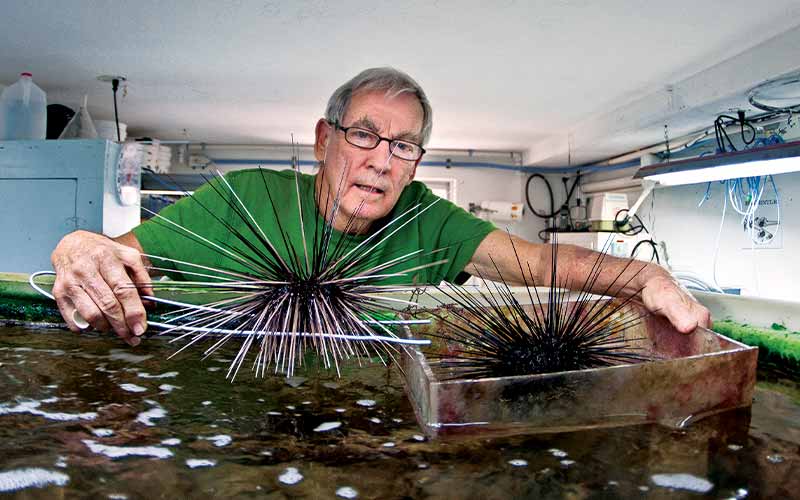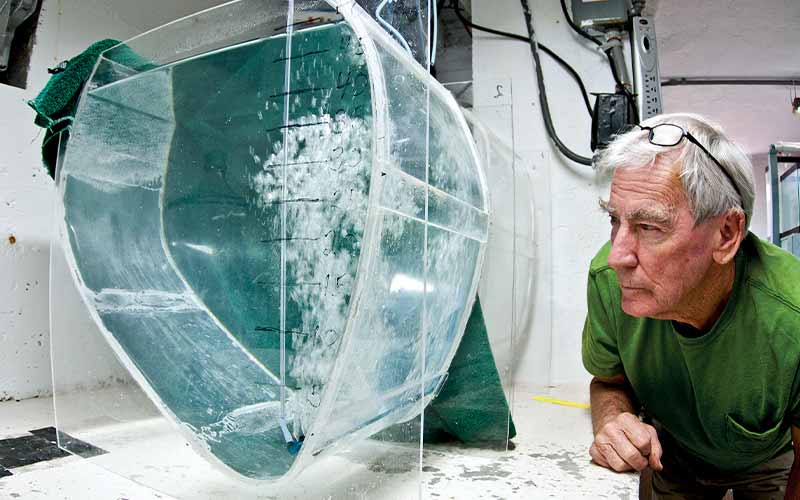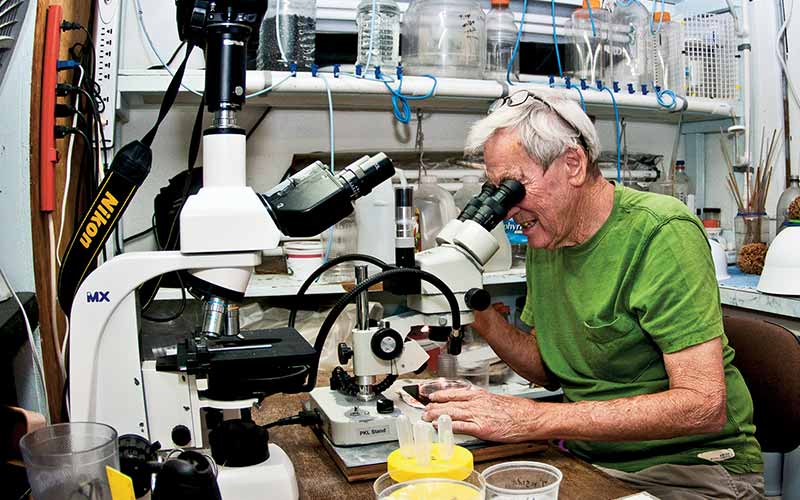The Great Plague
In the spring of 1983 the coral reefs of the Florida Keys were quite different than they are today. Although they faced the pressures of high visitation, pollution and extensive fishing, absolute coral cover was stable at around 25 percent. This was down from the 50 percent of the early ’70s, but live stony corals were still the dominant living structures of Keys reefs. On each coral head and in every rubble patch in the Keys there lived at least a few purple-black sea urchins with long, pointed spines, known for skewering wetsuits and unwary hands. Then, over the course of a single week in July 1983, the urchins were all dead or dying. Diadema antillarum were suddenly only a memory.
In only one year, beginning in January 1983, the Diadema plague extended from the southern Caribbean north to Bermuda. As currents spread the pathogen, 92 to 99 percent of all the billions of Diadema sea urchins in this vast 1.4-million-square-mile oceanic habitat died within 13 months. This was the most extensive mass mortality of any marine animal ever reported, and the species was suddenly very near extinction.

Diadema are (were) the keystone herbivores of the tropical western Atlantic reefs. They consume the macro algae that overgrow reefs, and their feeding activity cleans and scrapes the limestone substrates, stimulating settlement of coral and other invertebrate larvae. Without herbivores like Diadema, algae rapidly overgrows corals, greatly reducing sunlight, trapping sediments and even waging chemical warfare on coral tissues. Now, almost 30 years after the massive die-off, a limited return of the Diadema populations has occurred elsewhere in the Caribbean but not in the reefs of the Florida Keys. Ecological recovery of the Keys’ coral reefs is simply not possible without the return of Diadema.
When Diadema Return
Ken Nedimyer and I, both marine biologists and members of the Florida Keys National Marine Sanctuary Advisory Council, conducted a study to demonstrate what would happen if Diadema returned to the reefs. In the fall of 2001, with the support and counsel of the Marine Sanctuary staff and the National Undersea Research Center (NURC) of the National Oceanic and Atmospheric Administration (NOAA), we began work on a Diadema restoration project.
This project transferred at-risk juvenile urchins from rubble zones to deeper reefs to see if they could survive relocation and, if they did survive in adequate numbers (about one urchin per square meter), whether they could change the ecology of the reefs. We selected four small, 25-foot-deep patch reefs west of Pickles Reef near Key Largo. We introduced urchins to two of them — the experimental reefs — and observed the other two as control reefs. NURC assessed the ecology of all four reefs before and one year after relocation of the Diadema urchins. The ecological effects of the relocated urchins on the two experimental reefs in the short space of one year were remarkable.
On the experimental reefs, stony coral cover increased 59 percent, while on the control reefs stony coral cover declined 25 percent. The density of juvenile stony coral colonies, an indicator of the success of coral reproduction, increased 151 percent on the experimental reefs and only 55 percent on the control reefs. Crustose coralline algae, which promote settlement and survival of coral larvae, increased 160 percent on the experimental reefs and less than 1 percent on the control reefs. Brown macro algae that fight with coral for light and space decreased on the experimental reefs by 45 percent and increased on the control reefs by 31 percent.
This study empirically and emphatically demonstrated it is possible to restore Diadema to a Florida Keys coral reef, and that restoration can reverse the decline of coral and decrease the macro algae that shroud the reefs.
Culturing Diadema

Diadema are still present on the reefs of the Keys but in such small numbers they are not ecologically functional. A female Diadema can produce 15 million eggs at each spawning, but she must be close to a male for reproduction to succeed. Thus, if enough Diadema can be maintained on a reef to keep it clear of macro algae, the coral would benefit greatly and the urchins could spawn effectively. All that must be done is to develop the technology for hatchery culture of Diadema and then create a scientific program to establish and maintain functional populations on specific reefs. Surely this is not an impossible task, and justifiable if it can result in the restoration and protection of the Keys’ coral reef ecosystem, a true national treasure.
Spawning
I kept a brood stock of 20 to 35 adult Diadema in a 200-gallon saltwater system in my lab for more than four years. I found that simply placing adult urchins in a container of warm water stimulated them to spawn if they were ready. This process made it possible to spawn them whenever a rearing run was scheduled.

Larvae Rearing

Rearing Diadema larvae is more difficult than rearing the larvae of other sea urchins. Diadema larvae are among the smallest urchin larvae, and they have a long planktonic life. Metamorphosis from a planktonic larva into juvenile urchin may occur as early as 36 days but may take several months. The larvae require slow-moving water similar to oceanic currents as well as open-ocean water quality, making it difficult to maintain laboratory conditions necessary for their growth and development. Successful culture to mature larvae and metamorphosis into the early juvenile stage was routinely accomplished in my small laboratory; and although survival into stable, feeding juveniles was problematic, the basic spawning and larvae-rearing technology had been developed.
In the spring of 2011 the project entered its second phase and was transferred to Dave Vaughan at the Mote Marine Laboratory’s Tropical Research Lab (TRL) on Summerland Key. Vaughan is working with large-volume larvae-rearing tanks, successfully conducting post-metamorphosis feeding and producing many more viable juveniles. Beginning with the work at Tom Capo’s University of Miami laboratory and continuing with my work at my small lab and Vaughan’s work at Mote TRL, the project is now moving ahead toward juvenile urchin behavior studies and research in the placement and survival of Diadema on reefs. I am confident it will soon be possible to start the next phase of research: developing successful methods of restoring and maintaining functional populations of this critical herbivore on the coral reefs of the Keys.
Learn More
This research was made possible by funding from the Protect Our Reefs specialty license plate program sponsored by Mote Marine Laboratory. With continued funding and support, Diadema may soon return to the reefs of the Florida Keys. You can support Diadema restoration by visiting www.mote.org to volunteer, purchase the specialty plate (Florida residents) or make a donation. Will Keys reefs ever return to the 50 percent coral cover seen in the 1970s? That might be a stretch in our lifetimes, but with more Diadema on the reefs, coral restoration efforts by Ken Nedimyer’s team and the water-quality improvements from sewer installations replacing septic tanks, scientists are fighting the good fight.
© Alert Diver — Q1 Winter 2012